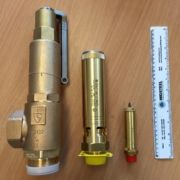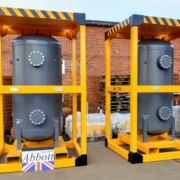Could you sell Steam Accumulators to your Clients ?
With such a focus on energy efficiency and carbon footprint it is strange that more steam accumulators aren’t being installed and used.

Could your clients save money by having a steam accumulator to smooth out peaks and troughs in their steam demand ?
If you like the idea of having something new to offer your clients, that might save them money, then read on…
If we can establish it is genuinely in your clients interests there is a job in it for you to supply/ install it, one for us to make it and one for David to size it.
David is the chap that wrote the article below that explains a bit more about the application and benefits of accumulators.
Can use this ‘knowhow’ to benefit your clients (oh and for is all to work together and make / install the odd accumulator perhaps ?
Beneath the article is the info you would need to get from your client to get an initial review of the system and if it might benefit from a full review.
David Oakland describes how steam accumulation can be harnessed to aid steam plant design and secure higher energy efficiency.
Energy managers are constantly coerced, whether because of legislative environmental directives or simply self-imposed responsibility, to find and implement alternative energy-efficient solutions to reduce their greenhouse gas emissions. The spin-off benefits are lower energy bills and increased bottom line profitability. Compliance with regulation and achieving energy cost reductions have become necessary bed-fellows.
A major concern for the steam plant designer is, in many cases, the fluctuating nature of the process steam demand to be met. The demand for steam from many industrial processes is erratic and step changes in load can have a detrimental effect on steam production and efficient power generation in the case of combined heat and power plant. However, there is a solution to this problem that not only removes the effect of transient steam loading completely from the steam raising or power plant but also improves energy efficiency and reduces operating costs. It is the incorporation of a ‘steam accumulator’ into the steam supply system. Steam accumulation is a long established but too often forgotten technology that, if correctly applied, can continue to be of great benefit to enhancing the design and performance of steam plant and cogeneration in the modern boilerhouse.
What can steam accumulation achieve?
Imagine a boiler able to reach a ‘peak’ demand ten times higher than its rated output. Consider that two out of a bank of three boilers might be eliminated and still allow the remaining boiler to reach the same ‘peak’.
Contemplate maintaining a low-pressure steam supply while diverting boiler output to critical high-pressure consumers. These are just three examples of the many application possibilities for steam accumulation.
The purpose of a steam accumulator is to provide the means to convert an irregular process steam demand into a steady load. The potential benefits are numerous, the primary one being significantly lower energy costs through increased operating efficiency. Additionally, it can provide immediate response to the steam demand, a secure steam supply at constant pressure,Btemperature and dryness, and will eliminate boiler priming high and low water lock-outs due to wide load swings. It can also assure product quality and – where new steam or power plant is required – result in lower capital costs. Crucially, it can achieve all this while reducing environmentalBpollution.
So what exactly is steam accumulation? In short, it is the storage (in a pressure vessel) of surplus steam produced at times of low demand forBsubsequent release to supplement the output of the boiler at times of high demand. Any industrial manufacturing process having a variable demand for steam and where an effective differential exists between boiler and process pressures can benefit from this energy efficient technology.
How do accumulators work?
Water is used as the heat storage medium. The reason becomes evident when the greater heat storage capacity of water is compared with that of the same volume of steam vapour at any given state of temperature and pressure. Most accumulators work on the ‘pressure-drop’ principle, whereby steam from the boiler or waste heat steam generator is charged at high pressure into the water causing a rise in temperature (and pressure) and steam for process is discharged from the water (as ‘flash’) at low pressure to meet the demand.
The size of the storage vessel depends on the difference in pressure raised in the boiler and that of the pressure required by the process, and the amount of storage required. Storage vessels can range in size from 1m3 to 150m3 in volume (and more), or be a multiple of vessels to achieve the required storage volume.
What industries can benefit?
Steam is an essential commodity for many industrial processes. TheBtechnology can be successfully applied to any manufacturing process where steam is used for batch processing or at highly fluctuating rates. These conditions can be found in food production, canning, distilling and brewing, chemical manufacture, textiles, rubber, paper and board, plastics, pharmaceuticals, steel making, laundries, ammunitions, brick and concrete curing, turbine testing, tyre manufacture, combined heat and power. The list is endless!
When it comes to the energy saving economics, the most important energy cost savings to be gained from steam accumulation derive from a reduction in the boiler output in combination with load stabilisation. In all cases, there are prospects for energy savings emanating from: the elimination of excess steam generating capacity and part-loading that causes a low load factor, the removal of a rapidly fluctuating demand and idle live capacity that increases standing heat and power losses. Therefore the possibility of a steam accumulator meeting a fluctuating steam demand with a smaller boiler operated at a higher load factor and at constant output with higher efficiency is real.
Expectations on energy savings will vary depending upon individual circumstances and as such, predictions on these and operational gains can only be generalised. However, a conservative expectation of improved boiler combustion efficiency for a modern boiler and burner equipment using the latest accumulator control methods could be between 2 to 4%, and potentially higher for older boiler plant. The necessary data from which to obtain the required information will likely be readily obtainable from the existing energy management system but with older plants where scant information is available, the addition of the necessary temporary or permanent instrumentation could easily be acquired.
Standing heat and power losses resulting from excess online steam generating capacity could equate to a further 1 to 3% of maximum boiler rating again depending on the type and age of the boiler. Where a boiler is of large refractory construction, savings on maintenance could have an even greater impact on the case for investment.
Operational gains
Fewer boilers online-operated under steady load conditions would lead to less wear and tear and as a result, lower maintenance costs. The potential for labour and material cost savings may be easily examined but it’s safe to say that a reduction in operating costs would contribute greatly to the decision to invest in the technology of steam accumulation.
David Oakland is principal consultant at <http://www.steamacc.co.uk/> David
Basic information required to enable an initial assessment of the potential for steam accumulation:
1) Industry type;
2) No of boilers
3) Size of Boilers , primary fuel etc;
4) Boiler Pressure (HP);
5) Type of processes operated (HP and LP);
6) Process pressure required (LP);
7) Brief description of steam demand, eg. peak demand profile (LP and HP if
applicable), peak rate, time duration, repeat cycle time etc (a graphical
depiction/chart recording would be ideal);
8) A brief description of the ‘problem’ or why a steam accumulator is
thought to be a possible solution;
9) Sketch of plant and layout processes would also be very handy
David’s article was published here: http://www.engineerlive.com/content/steam-accumulating-interest




Leave a Reply
Want to join the discussion?Feel free to contribute!